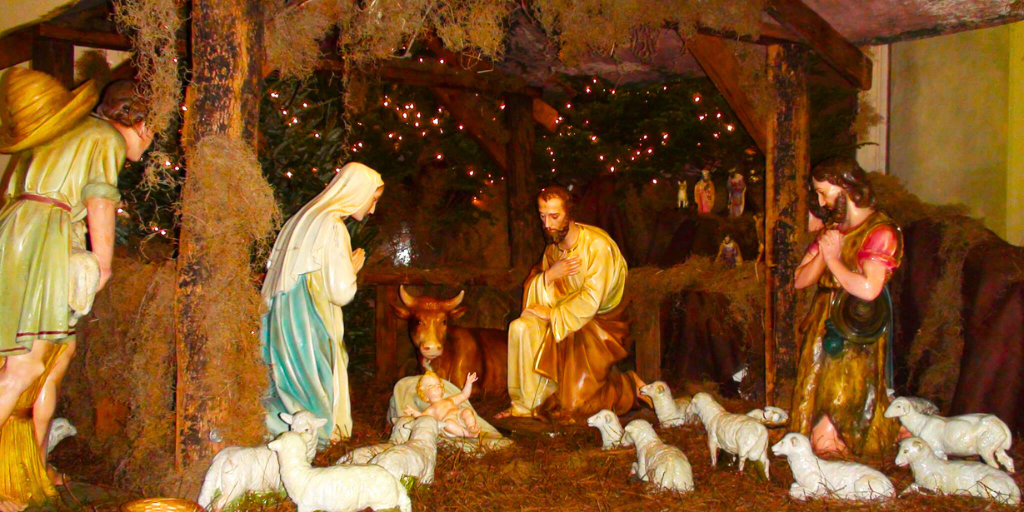
Connie Anderson recounts how the nativity scene became a beloved symbol of Christmas, beginning in Europe and coming through immigrants to the Americas.
For almost one hundred years, Macy’s annual Thanksgiving Day Parade, which ends with Santa Claus’ arrival, has impacted the way people view Christmas, not only in America but also across the world. The prosperity with which our country has been blessed has allowed us to spend the season in style. Yet, as soon as gifts are opened and dinners complete, Christmas trees are thrown out and decorations neatly put away. Christmas has come and gone, until the next year when the cycle starts all over again.
During colonial times, Catholics and fellow Christians celebrated the holiday season in a very different way. The inhospitable environment, the lack of financial resources, and the shortage of clergy severely tested both body and soul. The early settlers sought refuge in the New World to practice their Faith freely and to raise their families in peace. Celebrating Christmas with intentional reverence was a joyful part of their thanksgiving.
In the French Catholic colony of Louisiana, Christmas Day, which was preceded by the ancient penitential season of Advent, was not just a holiday, but was also a solemn Holy Day. Le jour de Noël (Christmas Day) initiated twelve additional days of celebration from December 26 through January 6, the Solemnity of the Epiphany, and the beginning of the festive season of Mardi Gras.
The Christ Child’s anticipated arrival motivated four weeks of prayer and penance to prepare adequately to receive the Savior of the World. An all-day fast on Christmas Eve was followed by Midnight Mass, celebrating the “Solemnity.”
After returning home, the famished guests ended their penitential wait with a special supper. Called le Réveillon (”the Waking”), the best meal that the family could afford was served. The meal often lasted until dawn, after which the family and guests, who had traveled for hours by horse or carriage over uneven dirt roads or by pirogue (boat) on one of Louisiana’s numerous waterways, slept the rest of the day.
Gift-giving took place on January 6, the feast of the Epiphany, when the Magi visited the Christ Child, bearing gifts of gold, frankincense, and myrrh. By today’s standards, gifts in Louisiana colonial households were pretty meager, a few handmade toys for the children, baked goods, assorted nuts, and candied fruit preserved in sugar, which was first granulated by New Orleans mayor, Etienne de Bore’, in 1795. The sugar kettle used and the spot where the granulation took place are now part of Audubon Park, near Tulane University in New Orleans.
In the early 1800s, many Louisiana colonial homes, which had members who had fled the French Revolution, began to display tiny creches, filled with treasured figures, made of plaster, wood, or clay. The clay santon, or “little saint,” became very popular in France after anticlerical revolutionaries closed churches and outlawed nativity scenes.

Catholics, particularly those in the French region of Provence who steadfastly refused to give up their faith, secretly brought the cherished Christmas tradition into their homes. First inspired by St. Francis of Assisi in 1223 in Greccio, Italy, when he staged a live nativity scene to bring beleaguered townsfolk to Christ, a French family’s private creche featured figurines of friends and neighbors, in addition to the Holy Family, animals, shepherds, Wise Men, and angels.
The family creche became a covert symbol of courageous French Catholicism, bringing together ordinary people to celebrate their unity in Jesus, the Prince of Peace. Today santons have become a thriving cottage industry in Provence, where a wide variety of charming figures and miniatures are beautifully made by small families, as well as by larger family-owned businesses.
Creches have continued to bring a wide variety of people to Christ, especially in times of difficulty. My own parish church, Sacred Heart of Jesus, Baton Rouge, LA, displayed its first tableau in December 1942, one year after our country entered WWII and many people were still suffering from the Depression.
The almost life-size images of the Christ Child and the Holy Family surely resonated with hope, especially for the Italian pastor and parishioners, whose native land was now at war with the United States. Undoubtedly many fervent prayers for peace and unity were said before this creche, which played an unforgettable role in my childhood Christmases many years later.
This Christmas, as we kneel before the creche in our church or home, let us remember that Jesus came intentionally to be part of our lives. In spite of ignorance, poverty, war, difficulties, and divisions of all kinds, the creche is a real place where His gifts of peace, love, and unity are still found. May our shared legacy of the Christmas creche remind us to make room for Christ courageously in our hearts and lives all year long.

Copyright 2023 Connie Anderson
Images: copyright 2023 Connie Anderson, all rights reserved.
About the Author

Connie Anderson
Connie Anderson retired from teaching, television, freelance film-making, and fundraising. A Baton Rouge, LA, native, she and her husband, Larry, are the proud parents of two adult children and grandparents of one recently adopted grandson. Connie is interested in passing on her Faith through stories about Louisiana’s rich Catholic family traditions, and encourages others to pass on theirs.


.png?width=1806&height=731&name=CatholicMom_hcfm_logo1_pos_871c_2728c%20(002).png)
Comments